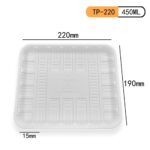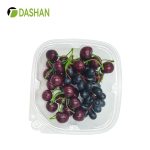Introduction
In the ever-evolving landscape of beverage packaging, the choice of material plays a pivotal role in determining product safety, functionality, and environmental impact. Polypropylene (PP) Cups, a versatile thermoplastic polymer, has emerged as a preferred material for disposable cups. This article delves into the multifaceted benefits of PP cups, their applications, environmental considerations, market dynamics, and future trends.

What Are Polypropylene Cups?
Polypropylene (PP) is a thermoplastic polymer characterized by its robustness, chemical resistance, and versatility. When molded into cup form, PP offers a lightweight yet durable solution for both hot and cold beverages.
Key Characteristics of PP Cups:
-
Heat Resistance: PP cups can withstand temperatures up to 120°C, making them suitable for hot beverages without warping or leaching harmful substances.
-
Chemical Inertness: The material does not react with acidic or alkaline substances, ensuring that the taste and quality of the beverage remain unaffected.
-
Transparency: PP cups offer excellent clarity, allowing consumers to view the contents clearly, which is particularly appealing for beverages with vibrant colors.
-
Durability: Resistant to cracking and breaking, PP cups are less prone to damage compared to alternatives like polystyrene.
Advantages of PP Cups
1. Food Safety and Compliance
PP cups comply with international food safety standards, including those set by the U.S. Food and Drug Administration (FDA) and the European Food Safety Authority (EFSA). They are free from bisphenol A (BPA) and other harmful chemicals, ensuring safe contact with food and beverages.
2. Versatility in Applications
PP cups are utilized across various sectors:
-
Beverage Industry: Ideal for serving coffee, tea, juices, and smoothies.
-
Foodservice: Commonly used in fast-food chains, cafeterias, and catering services.
-
Events and Promotions: Widely used in festivals, concerts, and promotional events due to their cost-effectiveness and customization options.
3. Cost-Effectiveness
Compared to materials like glass or ceramic, PP cups are more affordable to produce and transport. Their lightweight nature reduces shipping costs, and their durability minimizes breakage, leading to cost savings.


Environmental Considerations
1. Recyclability
PP is recyclable and can be processed into new products, reducing the demand for virgin materials. However, the recycling rate for PP varies by region, and effective recycling programs are essential to maximize its environmental benefits.
2. Environmental Impact
While PP cups are more environmentally friendly than some alternatives, they still pose challenges:
-
Degradation: PP is not biodegradable and can persist in the environment for extended periods.
-
Resource Consumption: The production of PP cups requires energy and raw materials, contributing to environmental footprints.
3. Sustainable Practices
Adopting sustainable practices, such as using recycled PP (rPP) and implementing take-back schemes, can mitigate the environmental impact of PP cups. Additionally, encouraging consumers to reuse cups can further reduce waste.
Market Dynamics and Trends
1. Market Growth
The global disposable cups market is experiencing significant growth. According to a report by Precedence Research, the market is projected to expand from USD 17.72 billion in 2025 to approximately USD 33.25 billion by 2034, growing at a compound annual growth rate (CAGR) of 7.24% .
2. Consumer Preferences
Consumers are increasingly favoring products that combine functionality with sustainability. PP cups, with their balance of durability and recyclability, meet these evolving expectations.
3. Technological Innovations
Advancements in manufacturing technologies have led to the development of PP cups with enhanced features, such as improved clarity, strength, and customization options. These innovations cater to the growing demand for personalized and premium packaging solutions.
Cost Analysis
1. Production Costs
The production cost of PP cups is relatively low due to the cost-effective nature of PP resin and efficient manufacturing processes. This affordability makes PP cups an attractive option for businesses aiming to reduce packaging expenses.
2. Transportation and Storage
The lightweight nature of PP cups reduces transportation costs and storage space requirements. Their durability also minimizes the risk of product loss due to breakage during transit.
3. Lifecycle Costs
Considering the entire lifecycle, including production, transportation, usage, and disposal, PP cups offer a cost-effective solution compared to alternatives like glass or ceramic cups, which involve higher production and transportation costs.
Future Outlook
The future of PP cups is shaped by several factors:
-
Regulatory Developments: Increasing regulations on single-use plastics may influence the adoption of PP cups. However, their recyclability positions them favorably compared to non-recyclable alternatives.
-
Consumer Behavior: Growing environmental awareness among consumers is driving demand for sustainable packaging solutions, prompting manufacturers to innovate and adopt eco-friendly practices.
-
Material Innovations: Ongoing research into biodegradable additives and alternative materials may lead to the development of more sustainable PP cups in the future.
Conclusion
Polypropylene cups offer a balanced solution in beverage packaging, combining safety, functionality, and environmental considerations. While challenges remain, particularly concerning recycling rates and environmental impact, advancements in technology and sustainable practices are paving the way for a more eco-friendly future. Businesses and consumers alike can contribute to this positive trajectory by making informed choices and supporting innovations in packaging materials.


References:
-
Precedence Research. (2025). Disposable Cups Market Size and Forecast 2025 to 2034. Retrieved from https://www.precedenceresearch.com/disposable-cups-market
-
ScienceDirect. (2025). Environmental and littering impacts of disposable cups. Retrieved from https://www.sciencedirect.com/science/article/pii/S2352550925000879
-
Accio. (2025). PP Cup Trends: Market Growth, Consumer Preferences & Sustainability. Retrieved from https://www.accio.com/business/pp-cup-trend
-
GreenMatch. (2024). Is Polypropylene Eco-Friendly? Stats & Trends. Retrieved from https://www.greenmatch.co.uk/polypropylene-environmental-impact
-
Expert Market Research. (2025). Plastic Cups Market Size, Share | Industry Report 2034. Retrieved from https://www.expertmarketresearch.com/reports/plastic-cups-market
Copyright Statement© 2025 Dashan Packing. All rights reserved.
This article is an original work created by the Dashan Packing editorial team.All text, data, and images are the result of our independent research, industry experience,and product development insights. Reproduction or redistribution of any part of this contentwithout written permission is strictly prohibited.
Dashan Packing is committed to providing accurate, evidence-based information andto upholding transparency, originality, and compliance with global intellectual property standards.





